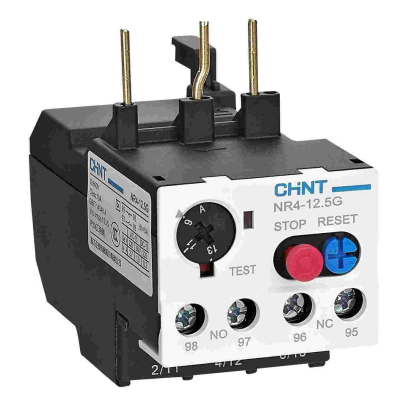What do A and H mean in the Chint thermal relay NR2-25?

In the Chint thermal relay NR2-25, **A** stands for Automatic, and **H** stands for Hand. They are used to set the reset mode of the thermal relay after an overload protection action. Chint NXR series thermal overload relays price
The thermal relay will operate when the motor is overloaded, causing the corresponding contacts to open to protect the motor. When A (automatic reset) is selected, after the thermal relay operates, after a period of cooling, its contacts will automatically return to the original state, and the motor can automatically restart. When H (manual reset) is selected, after the thermal relay operates, it is necessary to manually press the reset button for the contacts to return to the initial state before the motor can be restarted.
Generally, the blue button on the thermal relay is the reset button, which has two scales, A and H. A screwdriver can be used to rotate this button to select the desired reset mode.Chint Thermal Relay
The working principle of the Chint thermal relay **NR2-25** is based on the **thermal expansion characteristics of the bimetallic strip**, and it is mainly used for the overload protection of motors. Its core working process is as follows:
1. Core structure and key components*CHINT contactor price*
- **Bimetallic strip**: It is formed by rolling and bonding two metals with different expansion coefficients (such as iron-nickel alloy and iron-chromium-aluminum alloy), and it is the sensing element of the thermal relay.
- **Heating element**: It is connected in series with the main circuit of the motor. When current passes through it, heat is generated to heat the bimetallic strip.
- **Tripping mechanism**: It connects the bimetallic strip and the contact system and is triggered to trip when the bimetallic strip deforms.
- **Contact system**: It includes moving contacts and stationary contacts, which are connected in series in the motor control circuit (such as the contactor coil circuit).
- **Reset device**: It supports manual (H) or automatic (A) reset modes (refer to the previous explanation about "A/H").
2. The action process of overload protection*CHINT surge protector price*
(1) During normal operation*CHINT circuit breaker price*
- When the motor current is normal, the heating element generates less heat, the bimetallic strip remains in a straight state, the tripping mechanism does not operate, the contacts remain closed, the control circuit is normally powered, and the motor runs.
(2) During overload**
- When the motor is overloaded (the current exceeds the rated value), the temperature of the heating element rises, and the bimetallic strip bends towards the side with a smaller expansion coefficient due to the different expansion coefficients of the two sides of the metal.
- After bending to a certain extent, it pushes the tripping mechanism to operate, causing the moving contact to separate from the stationary contact, cutting off the control circuit (such as the contactor coil losing power), and the main circuit of the motor is also disconnected, stopping the operation.
(3) Cooling and reset**
- After the overload is eliminated, the bimetallic strip gradually cools down and returns to its original state.
- **Automatic reset (A gear)**: After the bimetallic strip cools down, the tripping mechanism automatically resets, and the contacts close again (a delay time needs to be set to avoid misoperation).
- **Manual reset (H gear)**: It is necessary to manually press the reset button to force the tripping mechanism to reset, and the contacts close (to prevent the motor from restarting directly without inspection).
3. Key characteristics and functions**
- **Inverse time characteristic**: The larger the overload current, the faster the bimetallic strip heats up, and the shorter the action time, which meets the requirements of motor overload protection (avoiding misoperation caused by short-term impact current and being able to respond quickly in case of continuous overload).
- **Temperature compensation**: Some models have a built-in temperature compensation bimetallic strip to offset the influence of environmental temperature changes on the action characteristics and ensure the protection accuracy.
- **Current adjustment**: Adjust the access resistance of the heating element (or the initial position of the bimetallic strip) through a knob to set the current threshold for overload protection (the current adjustment range of NR2-25 is usually 0.1~25A, suitable for motors of different powers).
4. Application scenarios**
It is mainly used for the overload protection of three-phase asynchronous motors. It is connected in series in the main circuit of the motor and forms a complete control and protection system together with contactors, circuit breakers, etc. When the motor's current exceeds the standard due to reasons such as excessive load, phase loss, and abnormal power supply voltage, the thermal relay will act quickly to prevent the motor from burning out.
Conclusion**
The Chint NR2-25 thermal relay converts the current signal into a mechanical action through the thermal-mechanical conversion principle of the bimetallic strip, achieving overload protection for the motor. It also has automatic/manual reset functions and is a commonly used protection element in industrial control.
The following is the detailed technical parameter table of Chint thermal relay **NR2-25**, which is compiled in combination with official samples and authoritative data, covering core performance and application details:
I. Basic Parameters
| Item | Parameter |
| Model | NR2-25 (Suitable for motor power range: 0.1~25A) |
| Number of Poles | 3 poles (Three-phase protection) |
| Rated Insulation Voltage | AC 690V (Complies with IEC 60947-4-1 standard) |
| Rated Impulse Withstand Voltage | 6000V (Meets the requirements of industrial-grade surge protection) |
| Rated Operating Voltage | AC 24~380V (Control circuit) |
| Ambient Temperature Range | -5°C~+40°C (Average temperature within 24 hours ≤+35°C) |
| Altitude | ≤2000 meters |
| Protection Class | IP20 (Front side) |
II. Current Specifications and Setting Ranges
| Current Specification | Setting Current Range (A) | Suitable Contactor Model | Recommended Fuse Specification (RT16) |
| NR2-25/0.1-0.16 | 0.1~0.16 | NC1/CJX2-09, NC7-09~22 | aM 0.25A / gG 2A |
| NR2-25/0.16-0.25 | 0.16~0.25 | NC1/CJX2-09, NC7-09~22 | aM 0.5A / gG 2A |
| NR2-25/0.25-0.4 | 0.25~0.4 | NC1/CJX2-09, NC7-09~22 | aM 1A / gG 2A |
| NR2-25/0.4-0.63 | 0.4~0.63 | NC1/CJX2-09, NC7-09~22 | aM 1A / gG 2A |
| NR2-25/0.63-1 | 0.63~1 | NC1/CJX2-09, NC7-09~22 | aM 2A / gG 4A |
| NR2-25/1-1.6 | 1~1.6 | NC1/CJX2-12, NC7-09~22 | aM 2A / gG 4A |
| NR2-25/1.25-2 | 1.25~2 | NC1/CJX2-18, NC7-25~32 | aM 4A / gG 6A |
| NR2-25/1.6-2.5 | 1.6~2.5 | NC1/CJX2-18, NC7-25~32 | aM 4A / gG 6A |
| NR2-25/2.5-4 | 2.5~4 | NC1/CJX2-25, NC7-25~32 | aM 6A / gG 10A |
| NR2-25/4-6 | 4~6 | NC1/CJX2-32, NC7-32~38 | aM 8A / gG 16A |
| NR2-25/5.5-8 | 5.5~8 | NC1/CJX2-32, NC7-32~38 | aM 12A / gG 20A |
| NR2-25/7-10 | 7~10 | NC1/CJX2-32, NC7-32~38 | aM 12A / gG 20A |
| NR2-25/9-13 | 9~13 | NC1/CJX2-32, NC7-32~38 | aM 16A / gG 25A |
| NR2-25/12-18 | 12~18 | NC1/CJX2-40, NC7-32~38 | aM 20A / gG 35A |
| NR2-25/17-25 | 17~25 | NC1/CJX2-50, NC7-32~38 | aM 25A / gG 50A |
III. Protection Characteristics
| Item | Parameter |
| Overload Tripping Characteristic | Inverse-time characteristic, complies with IEC 60947-4-1 standard |
| 1.05 Times the Setting Current | No operation within 2 hours (Cold start) |
| 1.2 Times the Setting Current | Operation within 2 hours (Hot start) |
| 1.5 Times the Setting Current | Operation within 2 minutes (Start after thermal equilibrium) |
| 7.2 Times the Setting Current | Tripping time: 2s ≤ Tp ≤ 10s (Cold start) |
| Phase Failure Protection | When the current of any two phases is 1.0 times the setting current and the third phase is 0.9 times, there is no operation within 2 hours; |
| When the current of any two phases is 1.15 times the setting current and the third phase is 0, operation occurs within 2 hours | |
| Temperature Compensation | Built-in bimetallic strip temperature compensation, and the protection accuracy is stable when the ambient temperature is -5°C~+40°C |
IV. Mechanical and Electrical Performance
| Item | Parameter |
| Reset Mode | Manual (H)/Automatic (A) optional, reset time ≤2 minutes (Automatic) |
| Auxiliary Contacts | 1 Normally Open (NO) + 1 Normally Closed (NC), contact capacity: |
| AC-15 380V 1.58A | |
| DC-13 220V 0.2A | |
| Installation Method | Plug-in type (matched with the contactor) or independent installation (fixed by a 35mm guide rail or screws) |
| Wiring Specification | Main circuit: 1~4mm² single-core/stranded wire, M4 screws; |
| Auxiliary circuit: 1~2.5mm², M3.5 screws | |
| Mechanical Life | ≥1 million times (No-load operation) |
| Electrical Life | ≥500,000 times (AC-15 load) |
| Overall Dimensions | 96×96×80mm (Independent installation) |
| Weight | Approximately 1kg |
V. Certifications and Standards
| Item | Parameter |
| Standards Complied With | GB/T 14048.4, GB/T 14048.5, IEC 60947-4-1 |
| Certification | CCC (China Compulsory Certification) |
VI. Selection and Application
1. **Suitable Motor Power**: Select according to the current specification, for example:
- 0.1~0.16A: Suitable for 0.04~0.06kW motors;
- 17~25A: Suitable for 7.5~11kW motors.
2. **Typical Application Scenarios**:
- Overload protection for industrial three-phase asynchronous motors;
- Long-term operation protection for equipment such as fans, water pumps, and compressors;
- Equipment that needs to be started and stopped frequently (used in conjunction with contactors).
VII. Precautions
1. **Setting Current Setting**: It needs to be adjusted according to the rated current of the motor. It is recommended to be 0.95~1.05 times the rated current of the motor.
2. **Environmental Requirements**: Avoid using it in an environment with high humidity (>90%RH) or corrosive gases.
3. **Reset Operation**: When manually resetting, press the red button. For automatic resetting, wait for the bimetallic strip to cool down to room temperature.
For more detailed installation manuals or customized parameters, you can refer to the Chint official website or contact technical support.


